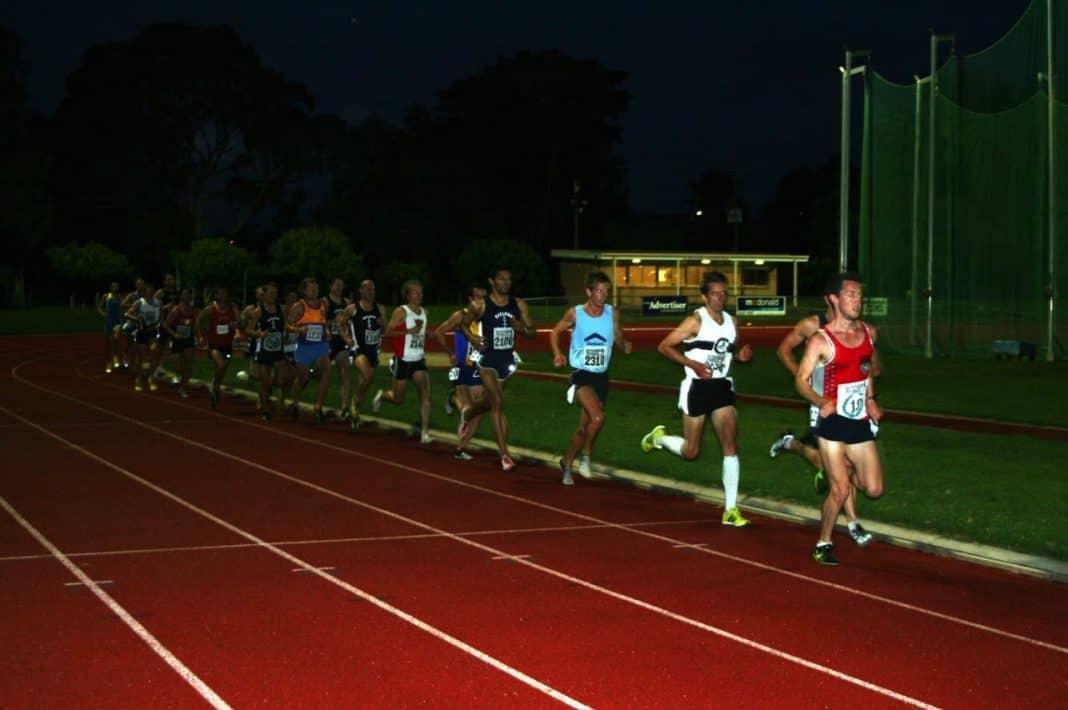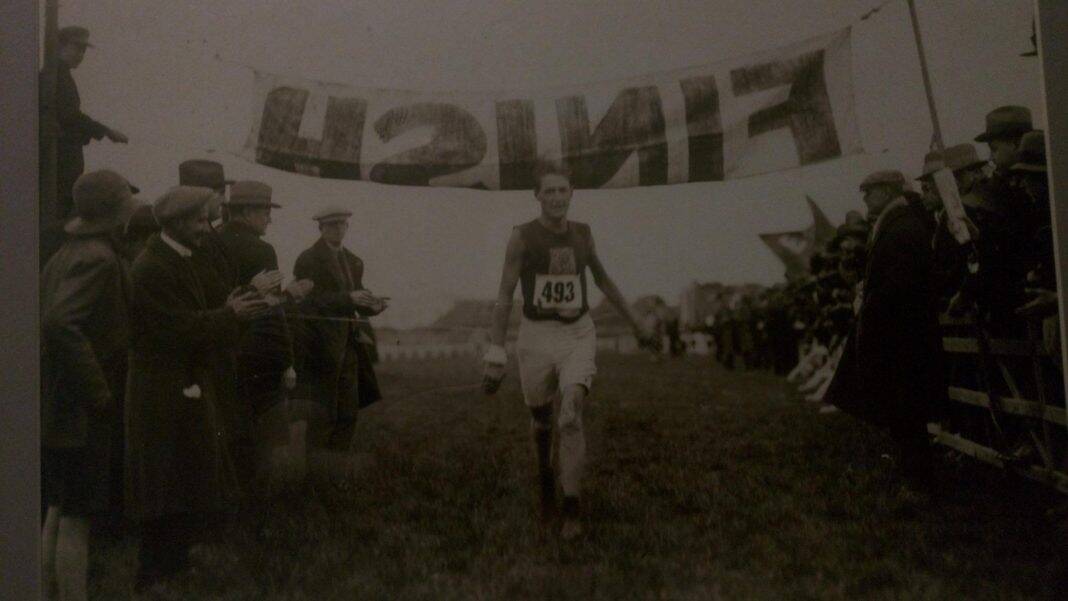By Jaryd Clifford – Runner’s Tribe
One week after Melbourne’s historic Olympic Park bore witness to its final Zatopek 10,000m in 2010, a motley crew of nineteen runners and two pacemakers filed onto Geelong’s Landy Field to toe the line in a comparatively modest race of the same distance. With personalised playlists blaring from the speakers and a banquet of beer and pizza waiting in the wings, the race would prove to be a resounding success. United in the deranged and masochistic pursuit of long distance running, the race struck a chord. Amidst the festivities that followed a vow was made. One day they would do it again.
That fateful night would in time become recognised as the inaugural running of what is now known as the Steigen Spectacular 10,000m. Eight years later it has expanded into one of the most prominent athletic meetings on the Australian calendar, with the original distance growing to become one of Australia’s premier twenty-five lap races.

The idea first emerged during Geelong running’s “golden days”. A dominant streak of Athletics Victoria cross-country titles, including back-to-back victories in the 2010 and 2011 series, showcased the depth in the region. With confidence at an all-time high, a plan was concocted to combat the group’s luckless toiling in club competition. Led by a band of coach-less runners, including current co-host of the Inside Running Podcast and 2:16 marathoner Julian Spence, unofficial time-trials covering distances of 3000m and 5000m began ritually embedding themselves in the weekly routine. Held late at night in optimal conditions and often paced to perfection, the innovative idea proved rewarding. It was this success that provoked the thought: Why not do the same for a 10,000m?
After the idea was accepted, the group sprung into action. Through the work of event coordinator Brett Coleman, they rallied the necessary officials to ensure the recognition of the event. Then the word spread to Melbourne, the flier selling it as “an excuse to catch up pre Xmas”. Before long a field was assembled, highlighted by the inclusion of future Olympic marathoner Liam Adams as the pacemaker. “The thought was that if we were going to do this, we might as well do it properly,” Coleman said.
All they needed now was a name. With one day left until the day of the race, shoe shop owner Scott Nicholas (2:18 marathoner) offered a voucher for the winner. Thus, the race became ‘The Running Company 10,000m’.

There was something special in the air on that first night. Sixteen runners finished (including the two pacemakers), with ten of them recording personal best performances. Another of the pacemakers, Scott Rantall, crossed the line first in 30:40.38, but the agreement was that Dane Verwey was the rightful victor, who crossed the line only half a second behind. Remarkably, he had shaved a full minute from his previous best time.
“That first Steigen remains my 10k PB. The fact that I haven’t been able to run that time before or since shows what a special race it can be for some people,” Verwey said. “It gave me belief. Races like this are needed. They go out too fast at Zatopek for those not quite there. It’s (Steigen) the perfect bridging race.”
Recognising the meet’s potential, 2006 Commonwealth Games 5000m representative Louis Rowan approached the group. He had recently established a brand of running socks called Steigen (German for ‘climb’) and was on the lookout for an opportunity to spread the word. This small 10,000m track race was the perfect debut project, and with his investment, the 2011 edition adopted the name used to this day: ‘Steigen Spectacular’.

However, Louis had ambitious dreams. He wanted to revolutionise the athletic experience. As an athlete, he had frustrated himself with the incredulous idea that you could be one of the best in the world and not get paid for it.
“It’s crazy to think that you can run an Olympic Games and not get paid when there are billions of people watching around the globe. It’s wrong on so many levels,” he said. Comparing it to actors not being paid for a performance, he voiced his concern for the current state of affairs once more on the Inside Running Podcast. “We need to look after athletes at the top level, and show people there is a way to glory…We’ve got to look after these people, and at the moment we’re not.”
With this philosophy in mind, Louis Rowan and Brett Coleman embarked on a steady expansion of the meet, with an emphasis on prizemoney for athletes. Pole Vault made its first appearance in 2011, and prize money was awarded to placegetters in the 10,000m for the first time. After racing a 1500m in Melbourne that morning, Walid A-Kurtu backed up to take out the first Steigen Spectacular 10,000m. He ran 30:35, eclipsing the race record.
Despite this positive shift, a lack of early entries the following year caused stress within the organising ranks. Some feared it could ruin the event.
“I was a bit nervous in the lead up that we wouldn’t have more than a few on the 10k start line, and that it would all fall flat,” Coleman said. “That would have been a failure. That could have been the end of the Steigen Spectacular.”
Luckily, the inclusion of arguably Australia’s greatest ever distance runner Craig Mottram as the pacemaker attracted a high-quality field. “It was incredibly exciting to have him running in Geelong, especially when he was so close to his prime,” Coleman said. Once he had stepped off the track, it was Brenton Rowe who stormed to victory, lowering the race record to 30:15. The race would survive.

The 2013 edition seemed to come and go as usual. The meet was slowly gaining momentum, this time expanding to include a women’s 1500m won by Brittany McGowan. However, the test of time marks this as a historical footnote. That year’s race played host to 18 year old Stewart McSweyn’s 10,000m track debut. With his eyes set on the world junior qualifier, his ambitions were high. His 5th place in 31:46.07 was respectable, although just falling short of the mark.
“I think I ran the first half way too hard and paid for it the second half,” he said. “It was a good stepping stone before stepping up the next few years to Zatopek…I think the big thing I learned was I had to respect the distance.” Fresh off the back of becoming the first Australian since Steve Moneghetti to claim back-to-back Zatopek titles, his words are high praise.
By 2015, the meet was booming. The newly added men’s Mile came with the added cash incentive of $2000 to break four-minutes, and under sweltering conditions, two runners accomplished the magic mark: Ryan Gregson (3:56.67) and Zak Patterson (3:59.56). However, the race had started at the wrong start line, tacking a further nine metres to the distance. For Brenton Rowe in third place (4:01.99), he can only wonder.

Later that night, hoses and sponges were enlisted to stave off the oppressive heat as Toby Rayner edged out Nick Earl for the win, equalling the race record with 30:15.
The next year witnessed the addition of an array of sprint events, with Olympian Morgan Mitchell sweeping victories in the 200m and 400m. However, it was the astonishing feat attempted by Jordan Gusman that had the crowd on the edge of their seats. After running a breathtaking 3:58 the week before in the Albie Thomas Mile, his mind was set on making it two sub-four-minute miles in one week. However, it was not to be. Agonisingly, he fell short by less than a second, stealing victory from Jordy Williamsz in the final stride with only six one-hundredths of a second separating the pair. Not satisfied with his week’s work, he fronted up again forty minutes later in the 10,000m, becoming the first runner to complete the painful double. His victory in 29:06.01 shattered the race record, with Mitch Brown only two seconds further back, and another three runners breaking the illustrious 30-minute barrier.

Further back in the field, fresh from her Melbourne Marathon victory, Virginia Moloney toughed it out to become the only female finisher in the race’s history. Her time of 32:53.04 was a personal best.
“This was the year I won Melbourne Marathon. We knew I was in form for a PB and after not achieving this at Zatopek the week before, we knew there weren’t many opportunities for a 10,000m,” she said. “While the men up front did their thing, we did ours in our group at the back…It was great going on the last lap. The commentator knew my goal, and the crowd was cheering. It is one of my favourite events.”
The Steigen Spectacular continued on its meteoric rise with 2017 welcoming a hoard of new events, including the important addition of a women’s 5000m after Sophie Ryan’s request for a 10,000m fell short of the required entry figures. Another innovative addition to the meet was the advent of the Superboot competition on the infield, awarding $2000 for the longest kick of the footy. This sparked interest outside the running world, enticing people to come and experience the athletics atmosphere for the very first time.
Further innovation appeared in the 10,000m, where $100 was given away to the leader at the end of each three-lap interval would win. However, eventual winner Nick Earl made it a one-man show, dominating the bonuses before taking victory in 29:57.81. Another great story from the race was that of Australian 3000m steeplechase record holder Shaun Creighton. After running 27:31.92 in 1996 to finally break Ron Clarke’s longstanding 10,000m record, he returned to the distance, shaving 35 seconds from the Australian over-50 record by running 32:19.71.
On the eve of the 2018 edition, it is safe to say that the Steigen Spectacular has well and truly cemented its position as one of the most anticipated meets of the summer. With over $20,000 in prize money, and boasting Olympians Peter Bol and Brett Robinson, as well as newly crowned Zatopek champion Sinead Diver, and sprint sensation Jack Hale, the meet will continue to grow.
Nevertheless, despite its transformation, the roots are never forgotten.
Inside Running’s Julian Spence is returning to the event in 2018, his mind set on the elusive 30-minute barrier. His words are succinct but true. The original concept remains.
“The event has helped to bridge the gap between elite and recreational running,”
And, for Louis Rowan, this is only the beginning.
“Eventually I want the Steigen Spectacular to be the biggest event on the Australian athletics calendar. With the best athletes from all over the globe on display. It might be ambitious, but I think it is possible.”
Bring on Saturday.
Winners of the Rod Muir 10,000m Classic

- 2010 Dane Verwey
- 2011 Walid A-Kurtu
- 2012 Brenton Rowe
- 2013 Craig Appleby
- 2014 Alan Craigie
- 2015 Toby Rayner
- 2016 Jordan Gusman
- 2017 Nick Earl
- 2018 ?
All-Time Top 10 List
1.Jordan Gusman, 29:06.01 (2016)
2.Mitch Brown, 29:08.08 (2016)
3.Jordan Nelson, 29:11.62 (2016)
4.Andy Buchanan, 29:17.03 (2016)
5.Nick Earl, 29:34.11 (2016)
Nick Earl, 29:57.81 (2017)
6.Julian Spence, 30:11.37 (2017)
7.Brady Threlfall, 30:13.39 (2017)
8.Toby Rayner, 30:15.03 (2015)
9.Brenton Rowe, 30:15h (2012)
10.Nick Earl, 30:18.06 (2015)
Nick Wightman, 30:20h (2012)
Many thanks to Brett Coleman for his passion and knowledge of the event.
“Brett Coleman is the lifeblood of the event. It wouldn’t run without him, and each year he commits his very sparse time to make sure it’s as good as it can be. Without Brett, the event doesn’t run. You will not meet a better bloke. Ever.”
-Julian Spence.